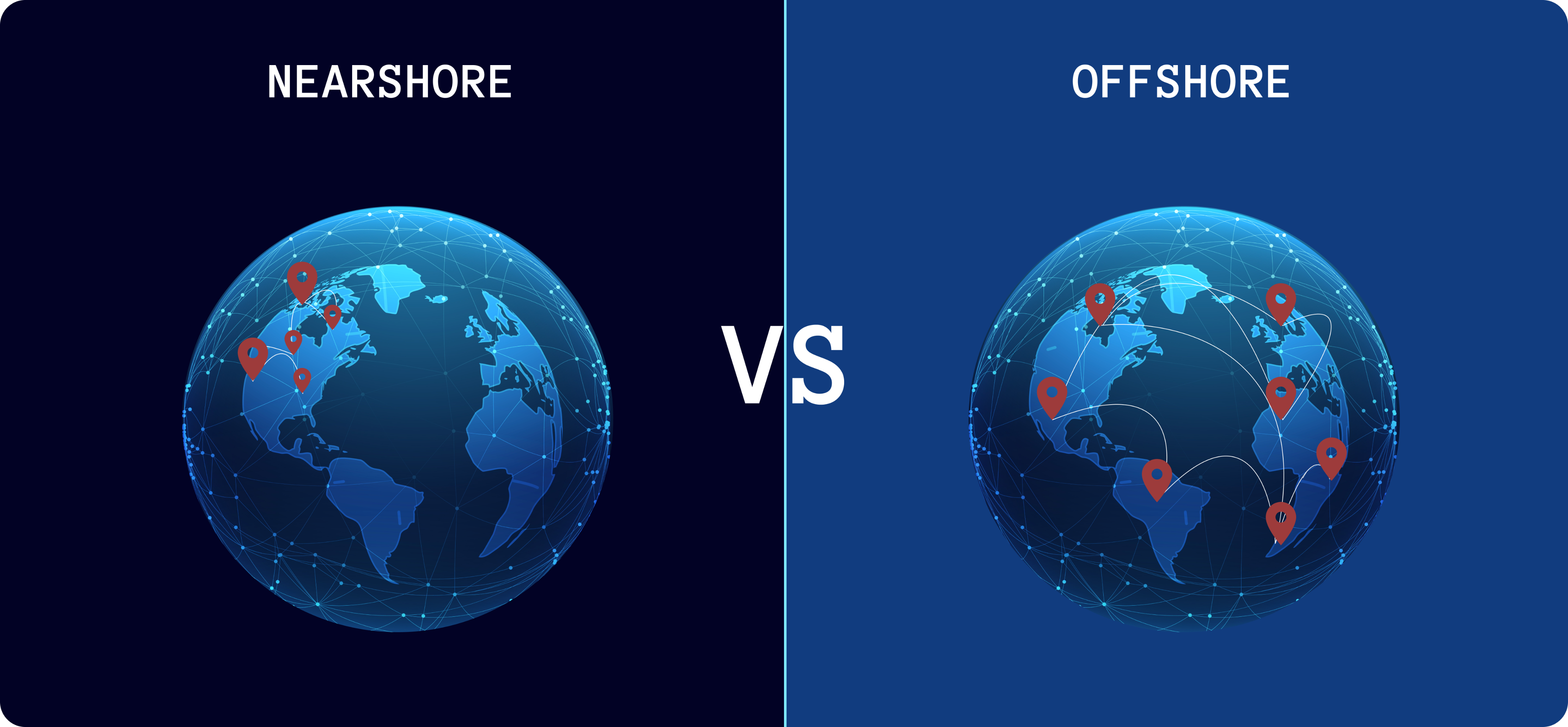Hiring the right talent to grow your company is always a challenge. When you need talent that specializes in data and AI, hiring can be even more difficult. According to a recent survey, more than half of IT leaders said their companies suffered due to a shortage of qualified AI talent. That's why many businesses are turning to outsourcing models, such as nearshore staff augmentation and offshoring.
Outsourcing allows companies to quickly hire highly-trained, skilled professionals without the costs and time investment of traditional recruiting. Additionally, it provides the opportunity to onboard workers on a temporary or project-specific basis. Staff augmentation is one of the most efficient ways to fill gaps in your team in specialized fields like data engineering and generative AI.
However, it's important to make strategic decisions that align with your business' needs. This leads many to wonder about the differences between nearshoring and offshoring. Understanding the core differences between these models is essential for augmenting your staff. If you choose a model that doesn't align, it can stall progress and waste essential resources.
In this guide, we're breaking down the unique features, advantages, and disadvantages of nearshoring versus offshoring so you can determine the best fit for your data and AI staff augmentation needs.
Staff Augmentation Models: The Basics
Nearshoring and offshoring are both examples of staff augmentation models. Overall, they share the same core function: each model integrates external talent directly into your team, providing specific expertise or offering extra coverage that your team lacks. The primary difference between nearshore staff augmentation and offshoring involves localization, such as time zone alignment and geographic distance.
Nearshoring Definition
As the name suggests, "nearshoring" involves augmenting your staff with professionals who are nearer to your location. In other words, your talent pool may be in another country, but this country is in your time zone or very close to it. If you're based in the United States, nearshoring staff augmentation would mean partnering with professionals in Canada, Mexico, or Central America.
Offshoring Definition
In contrast, offshoring means working with external talent in a more distant location. The geographic region and time zone are often a significant distance from your home country, often with a 6-12 hour time difference. For US companies, offshoring would involve working with a talent pool that's based in Asia, India, Africa, or another distant geographic region.
Pros and Cons of Nearshoring
If you're considering nearshore staff augmentation, it's important to understand how it balances cost efficiency and operational alignment. Nearshoring presents pros and cons, which need to be carefully assessed for their strategic potential.
Nearshoring Advantages
Advantages of nearshoring include:
- Compatible Time Zones: One of the greatest benefits of nearshore staff augmentation is that their time zones will be closer to your own. This makes it easier for your nearshore team to join meetings and participate in real-time collaborations.
- Easier Travel: Similarly, if your team needs to travel to your external staff's location (or vice versa), the travel time and costs will be lower.
- Shared Cultural Affinity: When you partner with a nearshore team in a neighboring country, you'll likely share a more similar business culture. This can simplify communication and promote stronger integration.
Nearshoring Disadvantages
Disadvantages of nearshoring include:
- Higher Costs: Although nearshore staff augmentation is more affordable than traditional recruiting, nearshore labor costs are often higher than offshoring.
- Smaller Talent Pool: Compared to global offshoring hubs, nearshore talent pools are often smaller. You may have difficulty finding professionals with niche skills like agentic AI or MLOps.
Pros and Cons of Offshoring
How does offshore staff augmentation differ from nearshoring? Offshoring is often a more popular model, in part due to its longer history as an established business practice. Additionally, it presents drastic cost savings and access to a very large global talent pool.
Advantages of Offshoring
Advantages of offshoring include:
- Round-the-Clock Coverage: Offshore teams are often 6-12 hours ahead, which can more easily enable a 24/7, follow-the-sun work cycle. Your team can seamlessly hand off tasks to offshore partners, who then continue working overnight.
- Lower Costs: Offshoring is generally more budget-friendly than nearshoring because offshore hubs are located in regions with lower wages.
- Massive Talent Pools: Many offshoring hubs have been established for decades, growing their talent pools to include a high volume of well-qualified candidates.
Disadvantages of Offshoring
Disadvantages of offshoring include:
- Communication Delays: Because offshoring partners are located in distant geographic locations, the significant time difference can lead to communication breakdowns. This may slow projects and lead to bottlenecks.
- Cultural and Language Barriers: Potentially, you may also experience differences in business culture, work style, and language that can lead to miscommunications. (However, the right offshoring partner will have a well-trained team and clear protocols to prevent or bypass any such cultural and language barriers.)
Choosing the Right Model for Your Business
Whether to choose nearshoring staff augmentation or offshoring depends on the nature of your business, your projects, your budget, and your need for real-time collaboration.
When to Consider Nearshoring
Nearshoring is often a better choice for high-stakes, time-sensitive projects that require heavy real-time collaboration. This includes data and AI projects such as:
- Building custom AI solutions
- Fine-tuning LLMs
- Scalable MLOps and deployment
When to Consider Offshoring:
Offshoring, on the other hand, presents a viable option for highly structured or independent tasks and projects that require less real-time collaboration.
- Large-scale data cleaning
- ETL processes
- Non-urgent maintenance
- QA tasks
A Smarter Way to Source Data and AI Talent
Choosing the right partner for external data and AI talent can help your business grow, while offering flexibility and cost savings compared to traditional hiring. If you're ready to grow your team, contact the JADA Squad today.
Frequently Asked Questions
What is nearshore staff augmentation?
Nearshore staff augmentation is a strategy where companies hire skilled professionals from an outsourcing vendor in a neighboring country or region with a minimal time zone difference.
What does staff augmentation mean?
Staff augmentation is a type of outsourcing where companies hire external staff to temporarily supplement their in-house workforce. It's typically done for specific projects or to fill gaps in skills. Unlike some outsourcing models, in staff augmentation, the client maintains direct control of the augmented staff's daily tasks and workflow.
What is an example of nearshore outsourcing?
An example of nearshore outsourcing would be a company in the United States hiring workers in a country in Central America, such as Mexico.


